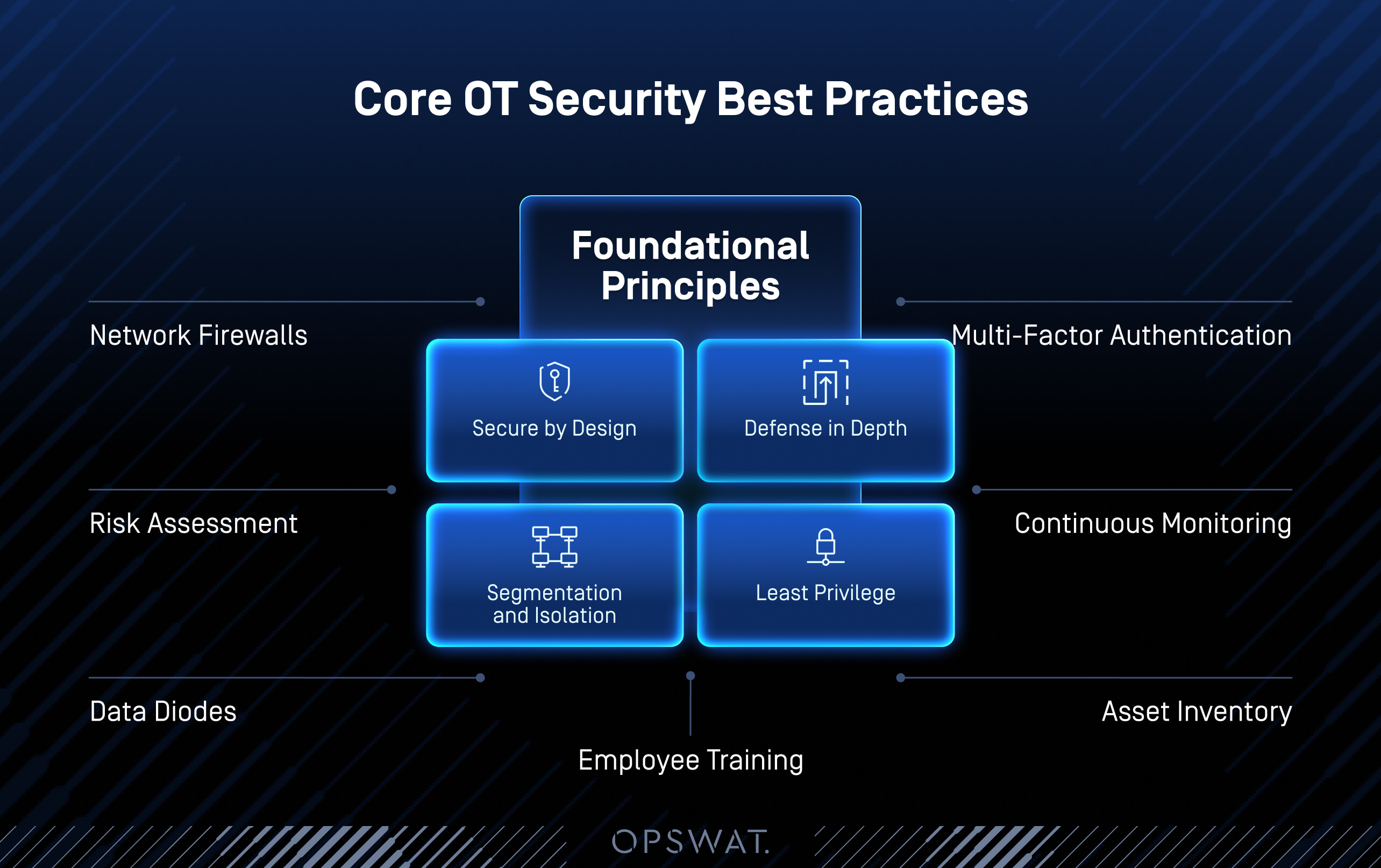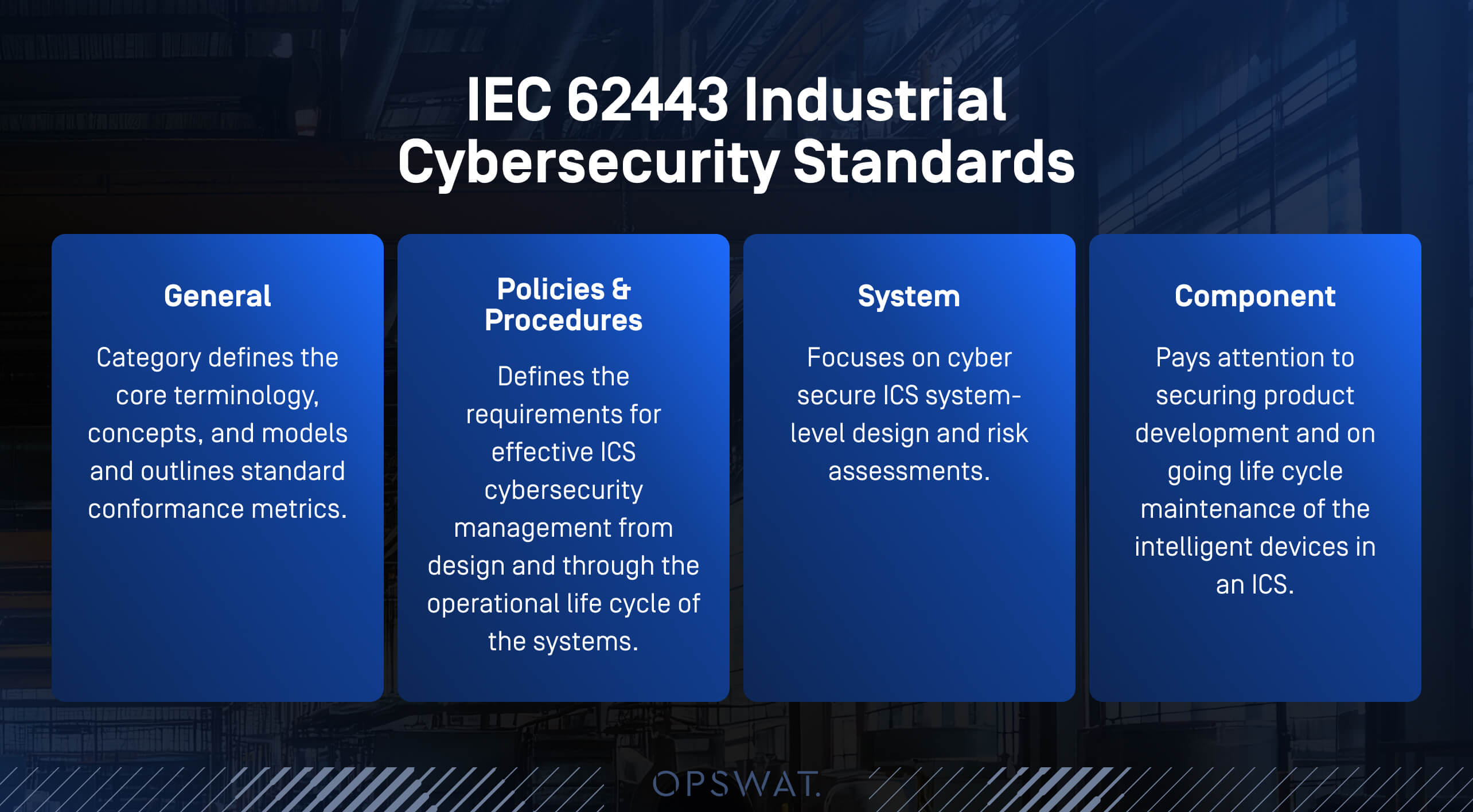- What is OT Security? Overview and Key Concepts
- Core OT Security Best Principles and Practices
- OT Security Frameworks, Standards, and Regulatory Compliance
- Implementing OT Security: Step-by-Step Checklist
- OT Security Architecture and Emerging Trends
- Comparing OT Security Tools and Capabilities
- Frequently Asked Questions (FAQs)
What is OT Security? Overview and Key Concepts
OT (Operational Technology) security refers to the strategies and technologies used to protect industrial systems and control networks such as SCADA systems, HMIS, PLCs, and other hardware/software that detect or cause changes through direct monitoring and control of physical devices.
Unlike traditional IT systems, OT environments manage physical processes in manufacturing plants, power grids, water treatment facilities, and other critical infrastructure. To understand the foundational concepts of OT security, explore our comprehensive guide on what is OT security. The importance of OT security has grown dramatically as industrial facilities increase their connectivity. Modern manufacturing environments integrate IoT (Internet of Things) devices, cloud systems, and remote monitoring capabilities. This connectivity creates new attack vectors that cybercriminals actively exploit, similar to application security challenges in traditional IT environments.
A key challenge in securing OT environments is that many of these systems were built decades ago, using legacy devices and instruments that were never designed with cybersecurity in mind. They often lack basic protections such as encryption, authentication, or secure communication protocols. To make matters worse, these systems often lack visibility, with limited telemetry and no centralized logging, which makes detecting and responding to threats extremely difficult. This is especially concerning because OT systems underpin many aspects of our daily lives and cyberattacks targeting them can lead to serious physical consequences—such as power outages, disrupted supply chains, water contamination, or compromised public safety.
Common OT environments span multiple industries. Energy companies rely on OT for power generation and distribution. Utilities manage water treatment and distribution through OT systems. Manufacturing facilities use OT systems to control production lines and quality assurance processes. Transportation networks depend on OT for traffic management and safety systems.
OT Security vs. IT Security: Key Differences
While IT security is primarily concerned with data processing, communication, and business operations, OT security focuses on safeguarding physical systems and processes, such as valves, motors, and assembly lines that drive critical infrastructure and industrial environments.
Although both aim to protect systems and data, OT environments present a distinct set of challenges shaped by their operational realities:
- Real-time operations require continuous uptime without interruption. Security patches that need system downtime can halt production for hours, making traditional IT approaches like frequent reboots impractical.
- Legacy systems installed decades ago run outdated operating systems that no longer receive vendor support or security patches, making them highly vulnerable to known exploits.
- Upgrading requires significant capital investment and operational disruption.
- Many Proprietary protocols weren't designed with security in mind, making them vulnerable to attacks. Standard IT security tools often don't support these specialized industrial communication protocols.
- Safety concerns mean that security controls must never compromise operational safety or create hazardous conditions for workers and the public.
Core OT Security Best Principles and Practices
Implementing effective OT security requires understanding both foundational principles and practical implementation methods. These work together to create robust OT cybersecurity programs.
Foundational Principles
- Defense in Depth: Multiple layers of security controls to protect against various attack vectors.
- Segmentation and Isolation: Separating OT networks from IT networks and isolating critical systems.
- Secure by Design: Building security into OT systems from the ground up rather than adding it later.
- Least Privilege: Granting users and systems only the minimum access required for their functions.
Best Practices
- Network Firewalls: Deploy firewalls between IT and OT zones to control traffic flow.
- Risk Assessment: Regularly evaluate vulnerabilities and threats to OT environments.
- Data Diodes: Use unidirectional gateways for secure one-way communications.
- Multi-Factor Authentication: Strong access controls help maintain appropriate permissions and prevent massive data breaches that can result from compromised credentials.
- Continuous Monitoring: Real-time threat detection and response capabilities.
- Asset Inventory: Maintain comprehensive visibility of all OT devices and systems.
- Employee Training: Address the human element through security awareness programs.

Network Segmentation and the Purdue Reference Model
Network segmentation divides systems into zones to prevent lateral movement by attackers. The Purdue Model is a well-established framework that outlines five levels of OT networks from physical processes at Level 0 to enterprise systems at Level 5. It enforces isolation between OT and IT layers.
The Purdue Model recommends implementing security controls between each level. Firewalls, intrusion detection systems, and access controls at these boundaries create defense-in-depth protection.
Zero Trust Principles in OT Environments
Zero trust architecture assumes that threats can originate from anywhere, including inside the network perimeter. This approach requires continuous verification of every user and device attempting to access OT systems.
- Least privilege access ensures users and systems receive only the minimum permissions necessary for their functions.
- Continuous verification monitors user and system behavior throughout their session. Unusual activities trigger additional authentication requirements such as MFA (multi-factor authentication) or access restrictions.
Continuous Monitoring and Threat Detection
Continuous monitoring provides real-time visibility into OT network activities and system behavior. This capability enables early threat detection and rapid response to security incidents.
SIEM (Security Information and Event Management) systems collect and analyze security data from multiple sources. These platforms correlate events to identify potential threats and automate initial response actions.
IDPS (Intrusion Detection and Prevention Systems) monitor network traffic for suspicious activities. These systems can detect known attack patterns and block malicious traffic automatically.
CTEM (Continuous Threat Exposure Management) provides ongoing assessment of an organization's threat landscape. This approach helps prioritize security efforts based on current risk levels and threat intelligence.
Employee Awareness and Training
Human error is a leading cause of OT security breaches. Best practices include:
- Conducting regular cyber hygiene training.
- Simulating phishing attempts.
- Creating OT-specific incident response drills.
OT Security Frameworks, Standards, and Regulatory Compliance
Established frameworks such as IEC 62443, the NIST Cybersecurity Framework, and regulatory standards like NERC CIP provide structured approaches for securing OT environments. These guidelines help organizations develop comprehensive security programs that meet industry requirements and regulatory compliance obligations.
IEC 62443: The Global OT Security Standard
IEC 62443 represents the most comprehensive international standard for OT security, addressing security throughout the entire lifecycle of industrial automation and control systems.
- Systematically assessing risk.
- Applying security levels to OT components.
- Ensuring security throughout the asset lifecycle.
General documents provide foundational concepts and terminology. Policies and Procedures documents address organizational security management. System documents cover technical security requirements. Component documents specify security requirements for individual system components.

NIST Cybersecurity Framework for OT
NIST Cybersecurity Framework offers a risk-based approach to cybersecurity that integrates effectively with OT environments, providing a common language for discussing cybersecurity risks and mitigation strategies.
- Tailored implementation tiers for OT/ICS.
- Integration with risk assessment and business continuity planning.
- Alignment with national critical infrastructure protection goals.
NERC CIP: Regulatory Standard for the North American Power Sector
The North American Electric Reliability Corporation’s Critical Infrastructure Protection (NERC CIP) standards are mandatory for entities operating the bulk electric system in North America. These standards focus specifically on securing cyber assets critical to reliable electricity delivery.
Implementing OT Security: Step-by-Step Checklist
Successful OT security implementation requires systematic planning and execution. This comprehensive checklist guides organizations through essential security implementation steps.
Effective OT security programs begin with thorough asset inventory and risk assessment. Organizations must understand what systems they need to protect before implementing security controls.
System hardening removes unnecessary services and configurations that could provide attack vectors. This process includes disabling unused ports, applying security patches, and configuring secure communication protocols.
Patch management maintains system security through regular updates while minimizing operational disruption. This process requires careful planning to balance security needs with operational requirements.
Incident response planning prepares organizations to respond effectively to security incidents. Well-developed plans minimize damage and reduce recovery time when incidents occur.
OT Security Checklist: Essential Steps
- Identify and Inventory all OT assets and devices.
- Conduct Risk Assessments based on asset criticality and threat landscape.
- Harden Systems by disabling unnecessary ports, services, and protocols.
- Implement Access Control with role-based permissions and authentication.
- Implement Patch Management and maintain vulnerability tracking systems.
- Monitor and Detect Threats through continuous network surveillance.
- Control Data Flow between IT and OT networks with proper segmentation.
- Develop and Test comprehensive incident response procedures.
- Ensure Business Continuity with backup strategies with secure enterprise data storage.
- Train and Create Awareness among personnel on OT security practices.
- Conduct Regular Auditing and security reviews for continuous improvement.
System Hardening in OT Environments
System hardening reduces the attack surface of OT systems by removing unnecessary features and services.
Disabling Legacy Protocols Unless Absolutely Required
Many OT systems still support outdated communication protocols like Telnet, FTP, or SMBv1, which lack encryption and are vulnerable to known exploits. Unless these protocols are essential for legacy equipment operation, they should be disabled or replaced with secure alternatives such as SSH or SFTP.
Applying Vendor-Validated Firmware and Security Patches
Develop a patch management process in coordination with equipment vendors to test and deploy updates during scheduled maintenance windows.
Configuring Secure-by-Default Settings
OT administrators should change default passwords, disable unused services and ports, and enforce strong authentication. Secure configurations should also align with recognized benchmarks, such as those from the CIS (Center for Internet Security).
Physical Security
Organizations using removable media or kiosks should implement media security best practices to prevent malware introduction through physical devices.
OT Security Architecture and Emerging Trends
Modern OT security architectures emphasize defense-in-depth strategies that provide multiple layers of protection. These architectures consider both cybersecurity and safety requirements throughout the design process.
Integration challenges arise as organizations connect OT systems to IIoT and cloud services. These connections provide operational benefits but create new security risks that require careful management. Organizations implementing cloud connectivity should follow cloud application security best practices to protect their OT data and systems.
Future trends in OT security include IT-OT convergence, AI-driven threat detection, and compliance-driven enhancements. Automation will streamline routine tasks, while security efforts shift toward cloud, edge, and CPS protection.
Securing Industrial IoT in OT Environments
IIoT (Industrial Internet of Things) devices bring connectivity and intelligence to traditional OT environments. These devices collect operational data, enable remote monitoring, and support predictive maintenance programs.
Unique IIoT risks stem from the combination of physical access, network connectivity, and often limited security capabilities. Many IIoT devices lack robust security features due to cost constraints and design priorities focused on functionality.
Best practices:
- Isolate IIoT devices with firewalls and VLANs.
- Use device authentication and encryption.
- Monitor IIoT activity for anomalies.
Organizations should also implement file security measures to protect sensitive operational data both at rest and in transit.
OT Security Architecture: Design Principles
Effective OT security architecture follows established design principles that address the unique requirements of operational technology environments. Layered defense strategies provide multiple security controls at different levels of the architecture, ensuring that if one control fails, others continue to provide protection. Resilience and redundancy ensure that security controls don't compromise operational availability and continue to function even when individual components fail or come under attack.
Comparing OT Security Tools and Capabilities
Selecting appropriate OT security tools requires understanding that no single solution can address all operational technology security needs effectively. Comprehensive OT protection demands multiple specialized capabilities working together as an integrated platform.
Three Core Capabilities of an OT Security Tool
Asset discovery and inventory provides visibility into all OT systems and devices. This capability automatically identifies connected devices, catalogs their characteristics, and maintains accurate asset inventory. By offering comprehensive asset discovery, network monitoring, inventory, and patch management capabilities, OPSWAT’s MetaDefender OT Security delivers unmatched visibility and control.
Active threat detection and response identifies potential security incidents and enables rapid response. MetaDefender Industrial Firewall and MetaDefender OT Security work in tandem to monitor network traffic, system behavior, and user activity and protect operations and process control networks.
Secure remote access and granular permissions ensure that only authorized users can access critical OT systems through controlled, secure channels. Unlike traditional VPNs, MetaDefender OT Access protects OT endpoints by implementing AD Server authentication and outbound-only firewall connections. Together with MetaDefender Endpoint Gateway, the system isolates OT and IT assets to ensure controlled access to critical infrastructure.
Protect Critical OT & Cyber-Physical Systems
For organizations seeking complete OT security coverage, OPSWAT's MetaDefender for OT & CPS Protection can proactively defend against advanced persistent threats and zero-day vulnerabilities while maintaining optimal performance and safety. By leveraging a cohesive, modular solution that integrates asset visibility, network protection, secure remote access, and safe data transfer, you gain the tools to secure OT and CPS environments and confidently meet the evolving challenges of today’s threat landscape.
Frequently Asked Questions (FAQs)
Q: What is OT security? | OT security protects operational technology systems that control physical processes in industrial environments. This includes programmable logic controllers (PLCs), supervisory control and data acquisition (SCADA) systems, and distributed control systems (DCS) used in manufacturing, energy, utilities, and transportation sectors. |
Q: What are the core OT security best practices? | Key best practices include network segmentation, zero trust principles, access controls, real-time monitoring, and employee training. |
Q: What are the major OT security standards? | Major OT security standards include IEC 62443 (the global standard for industrial automation security), NIST Cybersecurity Framework (risk-based approach), and ISO 27001 (information security management). |
Q: What are the three core capabilities of an OT security tool? | The three core capabilities are asset discovery and inventory (identifying and cataloging all OT systems), threat detection and response (monitoring for security incidents and enabling rapid response), and policy enforcement and compliance (ensuring systems operate according to security policies and regulations). |
Q: What are OT security policies? | Policies that define how OT systems should be accessed, monitored, and maintained to minimize risk. |
Q: What is the standard for OT security? | IEC 62443 is widely recognized as the global OT security standard. It addresses security throughout the entire lifecycle of industrial automation and control systems, providing detailed requirements for different security levels and system components. |
Q: What are system hardening requirements for an OT environment? | Disabling unused services, enforcing secure protocols, and regularly applying patches. |
Q: How to perform OT security? | By following a layered strategy involving asset inventory, risk assessment, system hardening, and real-time threat monitoring. |

